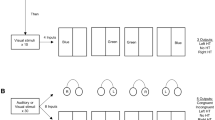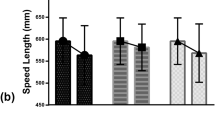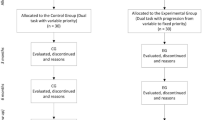Abstract
Dual task paradigms can be used to examine the interactions between cognition and the control of posture and gait. Measuring and interpreting changes in dual task performance is challenging, however, because many factors can influence performance. This study examined the effects of instructed focus and walking task difficulty, and the interaction between these factors, on dual task performance in healthy young adults. Fifteen participants performed a cognitive task while walking with either a usual base or a narrow base of support. Participants were instructed to focus on either the cognitive task or walking. Trade-offs both within and between tasks were assessed using the modified attention allocation index and the performance operating characteristic. Instructed focus influenced both the cognitive task and walking. Performance on the cognitive task was faster with instructions to focus on the cognitive task, and walking was faster (and more accurate in the narrow-base condition) with instructions to focus on walking. Walking task difficulty did not affect cognitive performance but did affect walking, with faster walking in the usual-base versus narrow-base condition. There was evidence of an interaction, with greater effects of instructed focus on the cognitive task during usual versus narrow-base walking. These results support the idea that the ability to flexibly shift attention allocation and task performance in response to instructions depends on the difficulty of the postural control task. The modified attention allocation index and the performance operating characteristic were instrumental in fully characterizing trade-offs between and within tasks in order to understand dual task performance changes. A clearer understanding of the factors that affect dual task walking and the interactions between these factors has important implications for the assessment of dual task performance in both clinical and research settings.




Similar content being viewed by others
References
Brach JS, Berlin JE, VanSwearingen JM, Newman AB, Studenski SA (2005) Too much or too little step width variability is associated with a fall history in older persons who walk at or near normal gait speed. J Neuroeng Rehabil 2:21
Brown LA, Shumway-Cook A, Woollacott MH (1999) Attentional demands and postural recovery: the effects of aging. J Gerontol A Biol Sci Med Sci 54:M165–M171
Brown LA, McKenzie NC, Doan JB (2005) Age-dependent differences in the attentional demands of obstacle negotiation. J Gerontol A Biol Sci Med Sci 60:924–927
Fraizer EV, Mitra S (2008) Methodological and interpretive issues in posture-cognition dual-tasking in upright stance. Gait Posture 27:271–279
Gage WH, Sleik RJ, Polych MA, McKenzie NC, Brown LA (2003) The allocation of attention during locomotion is altered by anxiety. Exp Brain Res 150:385–394
Hausdorff JM, Edelberg HK, Mitchell SL, Goldberger AL, Wei JY (1997) Increased gait unsteadiness in community-dwelling elderly fallers. Arch Phys Med Rehabil 78:278–283
Huxhold O, Li SC, Schmiedek F, Lindenberger U (2006) Dual-tasking postural control: aging and the effects of cognitive demand in conjunction with focus of attention. Brain Res Bull 69:294–305
Kelly VE, Schrager MA, Price R, Ferrucci L, Shumway-Cook A (2008) Age-associated effects of a concurrent cognitive task on gait speed and stability during narrow-base walking. J Gerontol A Biol Sci Med Sci 63:1329–1334
Kerr B, Condon SM, McDonald LA (1985) Cognitive spatial processing and the regulation of posture. J Exp Psychol Hum Percept Perform 11:617–622
Lajoie Y, Teasdale N, Bard C, Fleury M (1993) Attentional demands for static and dynamic equilibrium. Exp Brain Res 97:139–144
Lajoie Y, Teasdale N, Bard C, Fleury M (1996) Upright standing and gait: are there changes in attentional requirements related to normal aging? Exp Aging Res 22:185–198
Morgan AL, Brandt JF (1989) An auditory Stroop effect for pitch, loudness, and time. Brain Lang 36:592–603
Norman DA, Bobrow DG (1975) Data-limited and resource-limited processes. Cogn Psychol 7:44–64
Rapp MA, Krampe RT, Baltes PB (2006) Adaptive task prioritization in aging: selective resource allocation to postural control is preserved in Alzheimer disease. Am J Geriatr Psychiatry 14:52–61
Shumway-Cook A, Woollacott M (2000) Attentional demands and postural control: the effect of sensory context. J Gerontol A Biol Sci Med Sci 55:M10–M16
Shumway-Cook A, Woollacott M, Kerns KA, Baldwin M (1997) The effects of two types of cognitive tasks on postural stability in older adults with and without a history of falls. J Gerontol A Biol Sci Med Sci 52:M232–M240
Siu KC, Woollacott MH (2007) Attentional demands of postural control: the ability to selectively allocate information-processing resources. Gait Posture 25:121–126
Siu KC, Chou LS, Mayr U, Donkelaar P, Woollacott MH (2008) Does inability to allocate attention contribute to balance constraints during gait in older adults? J Gerontol A Biol Sci Med Sci 63:1364–1369
Sperling G, Melchner MJ (1978) The attention operating characteristic: examples from visual search. Science 202:315–318
Woollacott M, Shumway-Cook A (2002) Attention and the control of posture and gait: a review of an emerging area of research. Gait Posture 16:1–14
Woollacott M, Vander Velde T (2008) Non-visual spatial tasks reveal increased interactions with stance postural control. Brain Res 1208:95–102
Yogev-Seligmann G, Hausdorff JM, Giladi N (2008) The role of executive function and attention in gait. Mov Disord 23:329–342
Yogev-Seligmann G, Rotem-Galili Y, Mirelman A, Dickstein R, Giladi N, Hausdorff JM (2010) How does explicit prioritization alter walking during dual-task performance? Effects of age and sex on gait speed and variability. Phys Ther 90:177–186
Acknowledgments
This research was supported in part by the University of Washington Stolov Research Fund and the National Institutes of Health, National Institute of Child Health and Human Development (K01HD052018). We thank R. Price for engineering support and L. Flexner for recording the stimuli. We thank A. Schang, R. Hashish, J. Eastman, A. Nowak, A. Fish, S. Sirois, S. Woldemariam, and A. Gillespie for assistance with data collection and analysis.
Conflict of interest
The authors declare they have no conflict of interest.
Author information
Authors and Affiliations
Corresponding author
Rights and permissions
About this article
Cite this article
Kelly, V.E., Janke, A.A. & Shumway-Cook, A. Effects of instructed focus and task difficulty on concurrent walking and cognitive task performance in healthy young adults. Exp Brain Res 207, 65–73 (2010). https://doi.org/10.1007/s00221-010-2429-6
Received:
Accepted:
Published:
Issue Date:
DOI: https://doi.org/10.1007/s00221-010-2429-6




